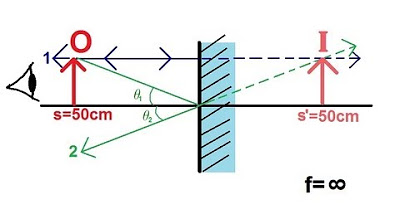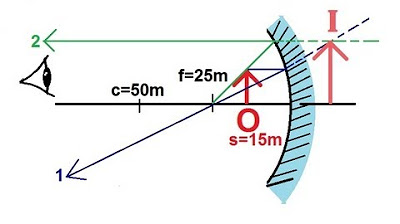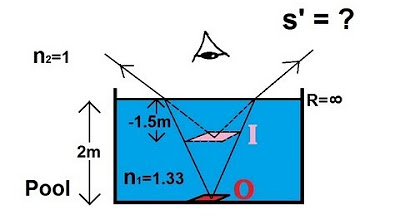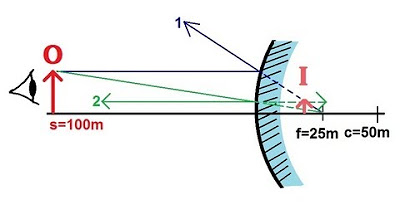Physics - Optics: Refracted Surface (4 of 5) Glass Ball
TLDRThis video script explores the concept of image formation through a glass sphere, demonstrating the principles of refraction. By placing an object within the sphere and using the lens maker's equation, the script calculates the position and properties of the resulting virtual image. The image is found to be upright, larger than the object by 36%, and located 7.3 cm from the sphere's surface on the same side as the object. The explanation includes the refraction of light rays and the observer's perception of the image, providing a clear understanding of how light interacts with refracting surfaces.
Takeaways
- 🔍 The example discusses the concept of image formation by a glass sphere with a radius of 10 cm and an index of refraction of 1.5.
- 👀 An object is placed 2 cm from the center and 8 cm from the edge of the sphere, with the observer positioned to the right of the sphere.
- 🌐 The equation used to find the image location is derived from the lens maker's equation, modified for a spherical surface.
- 🔢 The radius of curvature is considered negative because the sphere bulges towards the observer, indicating a diverging lens effect.
- ✍️ The calculation involves solving for the image distance (S') using the given values and the lens equation.
- 📉 The image distance is found to be -7.3 cm, indicating a virtual image formed on the same side as the object.
- 🔄 The negative sign of the image distance suggests that the image is closer to the sphere than the object, and it is upright.
- 📏 The magnification of the image is calculated using the formula m = -n1 * S' / (n2 * s), resulting in a 36% larger image than the object.
- 🔄 The magnification is positive, confirming that the image is upright.
- 💡 The explanation of how the image appears larger and upright involves understanding the refraction of light at the sphere's boundary.
- 📚 The script concludes by illustrating the principles of image formation with a spherical refracting surface, emphasizing the importance of refraction in determining the image's properties.
Q & A
What is the radius of the glass sphere mentioned in the example?
-The radius of the glass sphere is 10 cm.
What is the index of refraction of the glass sphere?
-The index of refraction of the glass sphere is 1.5.
How far is the object placed from the center of the sphere?
-The object is placed 8 cm from the edge, which is 2 cm away from the center of the sphere.
What is the observer's location relative to the sphere?
-The observer is located to the right of the sphere, outside in the air where the index of refraction is 1.
What equation is used to find the image distance in this problem?
-The equation used is \( \frac{N_1}{s} + \frac{N_2}{s'} = \frac{N_2 - N_1}{R} \), where \(N_1\) is the index of refraction inside the sphere, \(N_2\) is the index outside, \(s\) is the object distance, \(s'\) is the image distance, and \(R\) is the radius of curvature.
What is the radius of curvature in this problem, and why is it considered negative?
-The radius of curvature is -10 cm because the surface bulges towards the observer, indicating a negative radius.
Where is the image located according to the calculations?
-The image is located 7.3 cm away from the surface of the sphere on the same side as the object, indicating that it is a virtual image.
Is the resulting image upright or inverted?
-The image is upright, as indicated by the positive magnification value.
What is the magnification of the image, and what does it signify?
-The magnification is 1.36, meaning the image is 36% larger than the object.
How does the refraction at the boundary explain the location of the virtual image?
-The light ray bends away from the normal when passing through the boundary, causing the observer to perceive the image as coming from a position behind the boundary, leading to the formation of a virtual image.
Outlines
🔍 Refraction Through a Glass Sphere
This paragraph discusses the optical phenomenon of refraction using a glass sphere as an example. The sphere has a radius of 10 cm and an index of refraction of 1.5. An object is placed 2 cm from the center and 8 cm from the edge of the sphere. The observer is positioned to the right of the sphere. The problem involves calculating the position and characteristics of the image formed by the refraction through the sphere. The lens maker's equation is used to find the image distance (S') and is found to be -7.3 cm, indicating a virtual image located 7.3 cm from the sphere's surface on the same side as the object. The magnification is calculated using the equation m = -n1 * S' / (n2 * s), resulting in a 36% larger, upright image. The explanation includes a ray diagram to illustrate how the image appears to the observer due to the refraction of light at the sphere's boundary.
Mindmap
Keywords
💡Refracting Surfaces
💡Index of Refraction
💡Object Distance
💡Lens Formula
💡Radius of Curvature
💡Image Distance
💡Virtual Image
💡Magnification
💡Upright Image
💡Refraction
💡Normal
Highlights
The example involves a glass sphere with a radius of 10 cm and an index of refraction of 1.5.
An object is placed 2 cm from the center and 8 cm from the edge of the sphere.
The observer is positioned to the right of the sphere, with air as the external medium with an index of refraction of 1.
The lensmaker's equation is used to calculate the position of the image: \( \frac{n_1}{s} + \frac{n_2}{s'} = \frac{n_2 - n_1}{R} \).
The radius of curvature R is considered negative because it bulges towards the observer.
The equation is simplified to find the value of \( s' \), the image distance.
The calculation results in an image distance \( s' \) of -7.3 cm, indicating a virtual image on the same side as the object.
The image is located 7.3 cm away from the boundary surface, closer to the object.
A second equation is used to determine the size and orientation of the image: \( m = -\frac{n_1 s'}{n_2 s} \).
The magnification calculation shows the image is 36% larger than the object and upright.
Ray tracing explains the refraction process and why the observer perceives the image as coming from a different location.
The observer's perception is influenced by the bending of light rays at the boundary, creating a virtual image.
The example demonstrates the principles of image formation by a refracting surface.
The problem-solving process involves mathematical equations and geometrical optics.
Understanding the sign conventions for radius of curvature and image distance is crucial for accurate calculations.
The example provides practical insight into how lenses form virtual images and their properties.
Transcripts
Browse More Related Video

Physics - Optics: Refracted Surface (5 of 5)

Physics - Optics: Lenses (2 of 2) Diverging Lens

Physics 51/54 - Optics: Mirrors (6 of 6) Flat Mirror

Physics 54 Optics: Mirrors (3 of 6) Concave Mirror

Physics - Optics: Refracted Surface (1 of 5) Swimming Pool

Physics 54 Optics: Mirrors (4 of 6) Convex Mirror
5.0 / 5 (0 votes)
Thanks for rating: